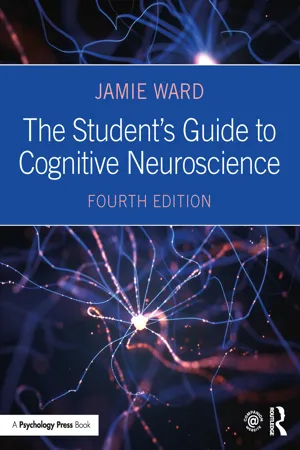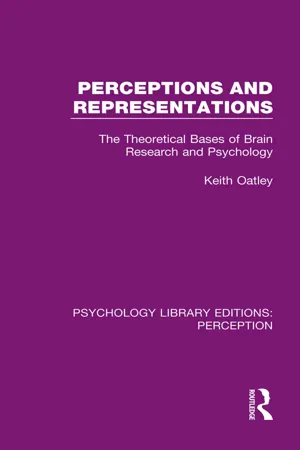Psychology
Lesioning Research
Lesioning research involves deliberately damaging or removing specific areas of the brain in order to study the resulting behavioral or cognitive changes. This method helps researchers understand the functions of different brain regions and their contributions to various psychological processes. Lesioning studies have provided valuable insights into the brain-behavior relationship and have contributed to our understanding of neurological disorders and cognitive functions.
Written by Perlego with AI-assistance
Related key terms
3 Key excerpts on "Lesioning Research"
- eBook - ePub
- Jamie Ward(Author)
- 2019(Publication Date)
- Routledge(Publisher)
Chapter 5 The lesioned brain and stimulated brainDOI: 10.4324/9781351035187-5CONTENTS- Dissociations and associations in neuropsychology
- Single-Case Studies in Cognitive Neuropsychology
- Group Studies and Lesion-Deficit Analysis in Neuropsychology
- Animal Models in Neuropsychology
- Transcranial magnetic stimulation (TMS)
- Transcranial Electrical Stimulation (tES)
- Summary and key points of the chapter
- Example essay questions
- Recommended further reading
Studies of humans who have been unfortunate enough to acquire brain damage have provided a rich source of information for cognitive neuroscientists. The basic premise behind the approach is that, by studying the abnormal, it is possible to gain insights into normal function. This is a form of “reverse engineering,” in which one attempts to infer the function of a component (or region) by observing what the rest of the cognitive system can and can’t do when that component (or region) is removed. Following brain damage, it may be possible to write but not speak, or recognize objects but not faces. In this way, lesions “carve cognition at its seams” (McCarthy & Warrington, 1990 ).From a contemporary perspective, studies of the effects of brain lesions on cognition can be regarded as one example of a wider class of approaches in which brain functioning is disrupted or stimulated in some way—either in humans or animals. This stands in contrast to other methods, such as EEG and fMRI, where some aspect of brain activity is recorded and for which the relationship between brain and behavior is correlational. Figure 5.1 gives an overview of these brain manipulation methods summarized according to their approximate temporal and spatial resolutions. It includes classical pharmacological manipulations on either the whole brain or local circuits; together with invasive electrical stimulation of neurons or—in genetically modified animals—by light stimulation of neurons that contain light-sensitive proteins that excite or inhibit neural activity (opto-genetics). Primarily used in humans, there are various noninvasive brain stimulation (NIBS) techniques of which transcranial magnetic stimulation (TMS) is the most famous. TMS involves magnetic stimulation of the intact brain to produce what has been described as “virtual lesions” or “reversible lesions” (e.g.,Pascual-Leone et al., 1999). A set of newer methods (tDCS, tACS, tRNS) are based on the principle of electrical stimulation (Nitsche et al., 2008). Like TMS, transcranial electrical stimulation (tES) - eBook - ePub
- Annette M. B. de Groot, Peter Hagoort, Annette M. B. de Groot, Peter Hagoort(Authors)
- 2017(Publication Date)
- Wiley-Blackwell(Publisher)
16 Lesion StudiesJuliana V. Baldo and Nina F. DronkersAbstract
Lesion studies are used to infer the neural basis of psycholinguistic processes in the healthy human brain. Traditionally, studies involved testing patients with a particular lesion site in order to ascertain the role of that particular brain region in the specific language process being tested. Newer methods using voxel-based techniques capitalize on advances in brain imaging to provide voxel-by-voxel analyses of the role that specific grey and white matter regions play in psycholinguistic processes. Common to all lesion study methodologies are a number of assumptions about the brain, as well as a number of challenges with respect to patient recruitment, stimulus selection, and data analysis and interpretation. In this chapter, we discuss these issues and provide an exemplary study that analyzes the neural correlates of auditory word recognition in a large patient sample. Last, we describe a number of advantages and disadvantages of lesion studies, as well as alternate methods.Introduction
Lesion analysis studies have a long and storied tradition in the study of speech and language. Starting in the late 1700s to early 1800s, a number of neurologic case studies led scientists to conclude that language could be localized to discrete regions of the left hemisphere. Such thinking ran counter to the previously dominant notion that the brain was indivisible and rather uniform in its support of language and other cognitive functions. With carefully described anatomical reports by Bouillaud, Lallemand, Broca, Wernicke, and others, it became clear by the end of the nineteenth century that there were indeed specific regions in the left hemisphere that subserved speech and language and that, moreover, these regions could be divided into sub‐regions that supported very specific functions such as speech production and auditory comprehension (see Whitaker, 1998 for an historical overview). - eBook - ePub
Perceptions and Representations
The Theoretical Bases of Brain Research and Psychology
- Keith Oatley(Author)
- 2017(Publication Date)
- Routledge(Publisher)
The above arguments do not, of course, mean that brain lesions cannot disclose important and unsuspected properties of the brain. Rather I want to suggest that they are inappropriate vehicles for asking the question of how a mechanism works. A much more appropriate target for the technique is the investigation of the brain’s resistance to damage: the surprising fact that the brain continues to go on working rather well despite enormous devastation of its parts, and despite other kinds of disruptive noise. This aspect is an apt target for the lesion technique. Clearly if the brain does continue to work quite well despite extensive damage or loss of any individual components, then this property sets it apart from almost every type of physical device with which we are familiar, in which damage to a single component typically makes the whole device defective or useless. One way of attacking this matter is to produce experimental brain lesions in order to investigate both the limits and nature of this remarkable property wherein the whole is more reliable than any of its parts, and the important work begun by Lashley on this problem will be discussed in a later chapter.A second use for the lesion is to isolate parts of the brain in the hope that the properties of these parts will be simpler than that of the whole. In a sense the neurophysiological study of a single nerve cell involves this kind of manipulation. Equally clearly the same principle is involved in studying an isolated ganglion in an invertebrate, an isolated retina, or an animal with only the spinal cord functioning and connected to the muscles. Particularly if the isolated part has some functional autonomy and is capable of giving rise to components of the behaviour of the whole organism it is entirely appropriate to suppose that studying the part may allow a simplification so that some mechanisms producing its behaviour can be more easily understood. In just the same way isolation of the teletypewriter of a computer from the main machine might be a valuable step towards investigating the particular properties of the teletypewriter. Removing all but one of its peripheral devices from a computer might be another good move, but in each case it is probably important that some normal communication channels remain. Thus though it is rather clear that study of the behaviour of animals with only the spinal cord working has led to important understanding of the nature of behaviour (e.g. Sherrington, 1906), it is by no means as clear that the study of the isolated slab of cortex (e.g. Burns, 1958) has the same kinds of potentiality for understanding how behaviour is produced, since we do not know how to communicate with it in a way that the cortex is usually communicated with, nor can we understand the significance of its responses.
Index pages curate the most relevant extracts from our library of academic textbooks. They’ve been created using an in-house natural language model (NLM), each adding context and meaning to key research topics.


